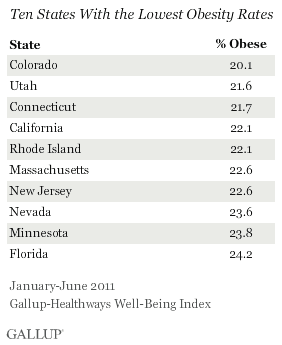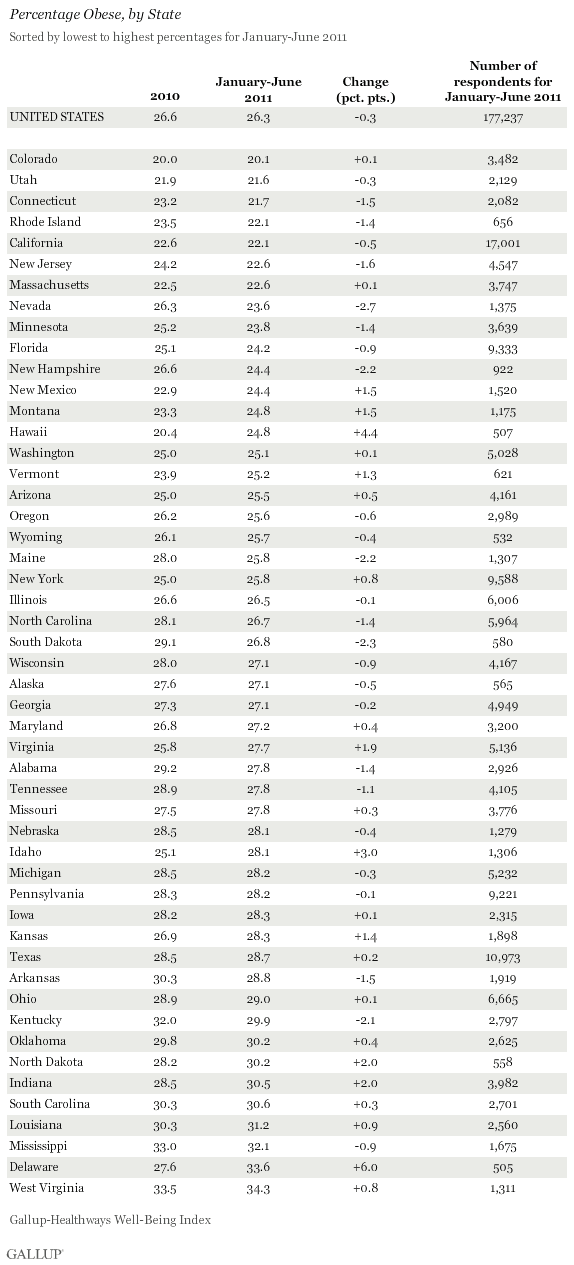WASHINGTON, D.C. -- Colorado continues to be the state with the lowest obesity rate in the country, at 20.1% in the first half of 2011. Fewer than one in four residents are obese in the 10 states with the lowest obesity rates. In the 10 states with the highest levels of obesity, rates are 29% or higher. West Virginia has the highest obesity rate in January through June 2011, at 34.3%, which is also the highest Gallup has measured for any state since it began tracking obesity rates in 2008.


These results are based on 177,237 interviews conducted daily from January through June 2011. Gallup tracks U.S. obesity levels as part of the Gallup-Healthways Well-Being Index, using Americans' self-reported height and weight to calculate Body Mass Index (BMI) scores. BMI scores of 30 or higher are considered obese.
The 26.3% obesity rate for the nation overall in January through June of this year is essentially unchanged from 26.6% in 2010. However, this 2011 rate is higher than the 25.5% in 2008. So far in 2011, obesity rates are generally more likely to be rising in the states where they are already the highest and declining in the places where they are lowest.
See page 2 for obesity rates for all states.
The states with the highest rates of obesity continue to be clustered in the South and the Midwest, as in past years. Western and Northeastern states still boast the lowest levels of obesity.

Bottom Line
While obesity in the United States as a whole remains unchanged so far in 2011 compared with last year, many of the country's most obese states continue to see the trend go in the wrong direction. At the same time, many states are registering improvements this year. Still, in no state are obesity rates lower than 20%, revealing residents throughout the entire country have much work to do to begin to tackle the nation's obesity problem.
This story is part of a series of midyear updates on Gallup's State of the States data, released in August on Gallup.com. Gallup.com will report new full-year totals in early 2012 based on all 2011 surveys.
About the Gallup-Healthways Well-Being Index
The Gallup-Healthways Well-Being Index tracks U.S. and U.K. well-being and provides best-in-class solutions for a healthier world. To learn more, please visit well-beingindex.com.
Survey Methods
Results are based on telephone interviews conducted as part of the Gallup-Healthways Well-Being Index survey Jan. 2-June 30, 2011, with a random sample of 177,237 adults, aged 18 and older, living in all 50 U.S. states and the District of Columbia, selected using random-digit-dial sampling.
For results based on the total sample of national adults, one can say with 95% confidence that the maximum margin of sampling error is ±0.2 percentage points. The margin of sampling error or most states is ±1-2 points, but is as high as ±4 points for smaller states such as Wyoming, North Dakota, South Dakota, Nebraska, and Hawaii.
The Gallup-Healthways Well-Being Index categorizes the District of Columbia as a congressional district.
Interviews are conducted with respondents on landline telephones and cellular phones, with interviews conducted in Spanish for respondents who are primarily Spanish-speaking. Each sample includes a minimum quota of 400 cell phone respondents and 600 landline respondents per 1,000 national adults, with additional minimum quotas among landline respondents by region. Landline telephone numbers are chosen at random among listed telephone numbers. Cell phone numbers are selected using random-digit-dial methods. Landline respondents are chosen at random within each household on the basis of which member had the most recent birthday.
Samples are weighted by gender, age, race, Hispanic ethnicity, education, region, adults in the household, and phone status (cell phone only/landline only/both, cell phone mostly, and having an unlisted landline number). Demographic weighting targets are based on the March 2010 Current Population Survey figures for the aged 18 and older non-institutionalized population living in U.S. telephone households. All reported margins of sampling error include the computed design effects for weighting and sample design.
In addition to sampling error, question wording and practical difficulties in conducting surveys can introduce error or bias into the findings of public opinion polls.
For more details on Gallup's polling methodology, visit www.gallup.com.

